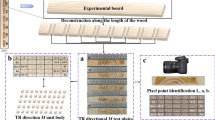Summary
A 2-D mathematical model was developed to simulate moisture movement and heat transfer in width and thickness directions within a softwood board during drying. The model is based on wood physiological features and behaviour observed during drying. In sapwood, liquid water movement is assumed to be a consequence of capillary action between liquid and gas phases inside the cell lumens. However, liquid flow does not occur in wood close to the exposed surfaces because at timber surfaces the wood cells are damaged during the sawing process and consequently the liquid column is broken. In heartwood, liquid flow is negligible since the pits are normally aspirated during the formation of heartwood in the growing tree. Water vapour moves under a partial vapour pressure gradient while bound water diffuses within the wood material due to differences in chemical potential. The model was solved numerically to predict moisture-content profiles. Experiments were undertaken to measure the moisturecontent gradient. Samples were removed from a tunnel dryer at intervals throughout drying, frozen overnight and then cut into slices for moisture-content determination. The experimental results were used to verify the model.
Similar content being viewed by others
References
Booker, R. E. 1989: Hypothesis to explain the characteristic appearance of aspirated pits. Proc. 2nd Pacific Region Wood Anatomy Conference, Forest Products Research and Development Institute, Laguna, Philippines
Booker, R. E. 1990: Changes in transverse wood permeability during the drying of Dacrydium cupressium and Pinus radiata. New Zealand J. Forest Sci. 20(2): 231–244
Booker, R. E.; Evans, J. M. 1994: The effect of drying schedule on the radial permeability of Pinus radiata D. Don Holz Roh-Werkstoff, 52: 150–156
Cown, D. J.; McConchie, D. L. 1991: Radiata pine wood property survey. New Zealand Forest Research Institute Bulletin No. 50 (revised), Rotorua, New Zealand
Ferguson, W. J.; Turner, I. W. 1994: A two-dimensional numerical simulation of the drying of pine at high temperatures. Proc. 4th IUFRO Wood Drying Conference, Rotorua, New Zealand: 415–422
Kho, P. S. C; Keey, R. B.; Walker, J. F. C. 1989: Effects of minor irregularities and air flows on drying of softwood timber boards in kilns. Proc. 2nd IUFRO Wood Drying Conference, Seatle: 150–157
Kamke, P. A.; Vanek, M. 1994: Comparison of wood drying models. Proc. 4th IUFRO Wood Drying Conference, Rotorua, New Zealand: 1–21
Kininmonth, J. A. 1970: An evaluation of timber drying problems in terms of permeability and fine structure. Ph.D. thesis, University of Melbourne, Australia
Langrish, T. A. G.; Keey, R. B.; Kho, P. C. S.; Walker, J. C. F. 1993: Time-dependent flow in arrays of timber boards: flow visualisation, mass-transfer measurement and numerical simulation. Chem. Eng. Sci., 48: 2211–2223
Laytner F. 1994: Staining radiata's reputation. New Zealand Forest Industries, 25(4): 55
Liu, J.; Avramidis, S.; Ellis, S. 1994: Simulation of heat and moisture transfer in wood during drying under constant ambient conditions. Holzforschung, 48(3): 236–240
Pang Shusheng 1994: The high temperature drying of Pinus radiata in a batch kiln. Ph.D. thesis, University of Canterbury, Christchurch, New Zealand
Pang, Shusheng; Langrish, T. A. G.; Keey, R. B. 1994: Moisture movement in softwood timber at elevated temperatures. Drying Technol., 12(8): 1897–1914
Patankar S. 1980: Numerical heat and fluid flow. New York: Hemisphere. 187p
Perré, P.; Moser, M.; Martin, M. 1993: Advances in transport phenomena during convective drying with superheated steam and moist air. Int. J. Heat and Mass Transfer. 36(11): 2725–2746
Plumb, O. A.; Spolek, G. A.; Olmstead, B. A. 1985: Heat and mass transfer in wood during drying. Intern. J. Heat Mass Transfer, 28(9): 1669–1678
Simpson, W. T.; Rosen, H. N. 1981: Equilibrium moisture content of wood at high temperatures. Wood Sci. Technol. 13: 150–158
Spolek, G. A.; Plumb, O. A. 1981: Capillary pressure of woods. Wood Sci. Technol. 15: 189–199
Stanish, M. A. 1986: The roles of bound water chemical potential and gas phase diffusion in moisture transport through wood. Wood Sci. Technol. 20: 53–70
Stanish, M. A.; Schajer, G. S. Kayihan, F. 1986: A mathematical model of drying for hygroscopic porous media. AIChE. J., 32(8): 1301–1311
Sutherland, J. W.; Turner, I. W.; Northway, R. L. 1992: A theoretical and experimental investigation of the convective drying of Australian Pinus radiata timber. Proc. 3rd IUFRO Wood Drying Conference, Vienna, Austria
Author information
Authors and Affiliations
Additional information
This work is supported by the New Zealand Foundation of Research, Science and Technology under contract CO4415
Rights and permissions
About this article
Cite this article
Pang, S. Moisture content gradient in a softwood board during drying: simulation from a 2-D model and measurement. Wood Sci.Technol. 30, 165–178 (1996). https://doi.org/10.1007/BF00231631
Received:
Issue Date:
DOI: https://doi.org/10.1007/BF00231631




